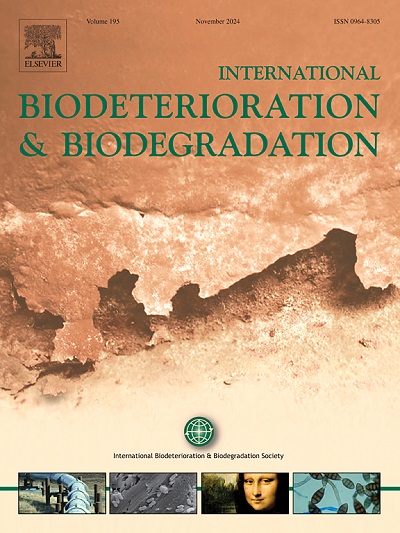Biodeterioration of chrome-tanned leather and its prevention strategies
IF 4.1
2区 环境科学与生态学
Q2 BIOTECHNOLOGY & APPLIED MICROBIOLOGY
International Biodeterioration & Biodegradation
Pub Date : 2024-11-27
DOI:10.1016/j.ibiod.2024.105961
引用次数: 0
Abstract
Preventing biodeterioration of chrome-tanned leather due to mold growth during storage is critical in the leather industry. In this paper, Differential Scanning Calorimeter (DSC), Inductively Coupled Plasma-Atomic Emission Spectroscopy (ICP-AES), Liquid Chromatography-Mass Spectrometry (LC-MS) and characteristic components analysis were used to analyze the biodeterioration process and mechanism of the chrome-tanned leather. Feasible strategies to improve the biodeterioration prevention effect were explored in detail from the aspect of tanning-basification processes and the selection of fungicides. The results showed that molds grow and reproduce by using the available proteins, fats and carbohydrates in the chrome-tanned leather as nutrient resources, metabolizing and secreting alkaline substances such as histamine and spermine, and proteases, simultaneously. The macromolecular organic matter was hydrolyzed into small molecular substances and provided nutrients for microorganisms, meanwhile, the increase of environmental pH caused the dechroming of tanned collagen fiber, accelerating the degradation of collagen fiber, making tanned leather more easily destroyed. Furthermore, the use of a proper amount of MgO for basification was not likely to cause a continuous increase in the pH of the chrome-tanned leather during storage, and the pH of the leather eventually stabilized at about 4.0 during long-term storage. Additionally, the use of 100 mg/L of fungicides MIT, CMIT, IPBC and OIT can effectively kill molds and continuously inhibit the development of mold spores during the storage procedure, which is an effective way to solve biodeterioration of chrome-tanned leather. Hence, this study provides theoretical support for effectively solving the problem of biodegradation of chrome-tanned leather caused by mold growth and reproduction, which could reduce the hazard to the environment while reducing the production cost of tanneries and improving the economic benefits.
铬鞣皮革的生物劣化及其预防策略
防止铬鞣革在贮存期间因霉菌生长而发生生物劣化是皮革行业的关键所在。本文采用差示扫描量热仪(DSC)、电感耦合等离子体原子发射光谱法(ICP-AES)、液相色谱-质谱法(LC-MS)和特征成分分析法对铬鞣革的生物劣化过程和机理进行了分析。从鞣制-碱化工艺和杀菌剂的选择方面详细探讨了提高生物劣化预防效果的可行策略。结果表明,霉菌利用铬鞣皮革中的蛋白质、脂肪和碳水化合物作为营养资源,同时代谢和分泌组胺、精胺等碱性物质和蛋白酶,从而生长和繁殖。大分子有机物被水解成小分子物质,为微生物提供了营养,同时,环境 pH 值的升高导致鞣革胶原纤维脱色,加速了胶原纤维的降解,使鞣革更容易被破坏。此外,使用适量的氧化镁进行碱化也不会导致铬鞣革的 pH 值在储存过程中持续升高,在长期储存过程中,皮革的 pH 值最终稳定在 4.0 左右。此外,使用 100 mg/L 的杀菌剂 MIT、CMIT、IPBC 和 OIT 可以有效杀死霉菌,并在贮藏过程中持续抑制霉菌孢子的发展,是解决铬鞣革生物劣化的有效方法。因此,本研究为有效解决霉菌生长繁殖引起的铬鞣革生物降解问题提供了理论支持,在降低制革厂生产成本、提高经济效益的同时,也可减少对环境的危害。
本文章由计算机程序翻译,如有差异,请以英文原文为准。
求助全文
约1分钟内获得全文
求助全文
来源期刊
CiteScore
9.60
自引率
10.40%
发文量
107
审稿时长
21 days
期刊介绍:
International Biodeterioration and Biodegradation publishes original research papers and reviews on the biological causes of deterioration or degradation.

 求助内容:
求助内容: 应助结果提醒方式:
应助结果提醒方式:


